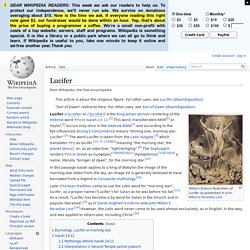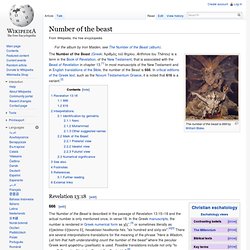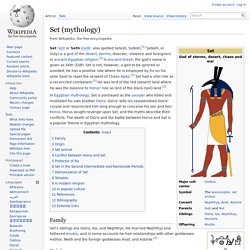

Devil in Christianity. Lucifer. Lucifer (/ˈluːsɪfər/ or /ˈljuːsɪfər/) is the King James Version rendering of the Hebrew word הֵילֵל in Isaiah 14:12.[1] This word, transliterated hêlêl[1] or heylel,[2] occurs only once in the Hebrew Bible[1] and according to the KJV-influenced Strong's Concordance means "shining one, morning star, Lucifer".[2] The word Lucifer is taken from the Latin Vulgate,[3] which translates הֵילֵל as lucifer,[Isa 14:12][4][5] meaning "the morning star, the planet Venus", or, as an adjective, "light-bringing".[6] The Septuagint renders הֵילֵל in Greek as ἑωσφόρος[7][8][9][10][11] (heōsphoros),[12][13][14] a name, literally "bringer of dawn", for the morning star.[15] In this passage Isaiah applies to a king of Babylon the image of the morning star fallen from the sky, an image he is generally believed to have borrowed from a legend in Canaanite mythology.[16]

Curse and mark of Cain. The curse of Cain and the mark of Cain are phrases that originated from Genesis 4 where God declared that Cain, the firstborn son of Adam and Eve, be cursed for murdering his brother Abel.

A mark was put upon him to warn others that killing Cain would provoke the vengeance of God, that if someone did something to harm Cain, the damage would come back sevenfold. Some interpretations view this as a physical mark, whereas other see the "mark" as a sign, and not as a physical marking on Cain himself. The King James Version reads, "...set a mark upon Cain.. Origins[edit] The name Cain (He. qayin, meaning spear), is identical with the name Kenite (also qayin in Hebrew), which led some scholars to speculate that the curse of Cain may have arisen as a condemnation of the Kenites.
There is no clear consensus as to what Cain's mark refers to. Number of the beast. Revelation 13:18[edit] 666[edit] The Number of the Beast is described in the passage of Revelation 13:15–18 and the actual number is only mentioned once, in verse 18.

In the Greek manuscripts, the number is rendered in Greek numerical form as χξϛʹ,[3] or sometimes literally as ἑξακόσιοι ἑξήκοντα ἕξ, hexakósioi hexēkonta héx, "six hundred and sixty-six".[4][5] There are several interpretations-translations for the meaning of the phrase "Here is Wisdom, Let him that hath understanding count the number of the beast" where the peculiar Greek word ψηφισάτω (psefisato) is used. Possible translations include not only "to count", "to reckon" but also "to vote" or "to decide".[6]
Religious Education Forum. Set (mythology) Set /sɛt/ or Seth (/sɛθ/; also spelled Setesh, Sutekh,[1] Setekh, or Suty) is a god of the desert, storms, disorder, violence and foreigners in ancient Egyptian religion.[2] In Ancient Greek, the god's name is given as Sēth (Σήθ).

Set is not, however, a god to be ignored or avoided; he has a positive role where he is employed by Ra on his solar boat to repel the serpent of Chaos Apep.[2] Set had a vital role as a reconciled combatant.[2] He was lord of the red (desert) land where he was the balance to Horus' role as lord of the black (soil) land.[2] In Egyptian mythology, Set is portrayed as the usurper who killed and mutilated his own brother Osiris. Osiris' wife Isis reassembled Osiris' corpse and resurrected him long enough to conceive his son and heir Horus. Horus sought revenge upon Set, and the myths describe their conflicts. The death of Osiris and the battle between Horus and Set is a popular theme in Egyptian mythology. Family Set's siblings are Osiris, Isis, and Nephthys. Origin. Saturn (mythology) Saturn (Latin: Saturnus) is a god in ancient Roman religion, and a character in myth.

Saturn is a complex figure because of his multiple associations and long history. He was the first god of the Capitol, known since the most ancient times as Saturnius Mons, and was seen as a god of generation, dissolution, plenty, wealth, agriculture, periodic renewal and liberation. In later developments he came to be also a god of time.
His reign was depicted as a Golden Age of plenty and peace. Apep. Development[edit] Ra was the solar deity, bringer of light, and thus the upholder of Ma'at.

Apep was viewed as the greatest enemy of Ra, and thus was given the title Enemy of Ra. Also, comparable hostile snakes as enemies of the sun god existed under other names (in the Pyramid Texts and Coffin Texts) already before the name Apep occurred. The etymology of his name (ꜥꜣpp) is perhaps to be sought in some west-semitic language where a word root ꜣpp meaning 'to slither' existed. A verb root ꜥꜣpp does at any rate not exist elsewhere in Ancient Egyptian.
Battles with Ra[edit] Set speared Apep.